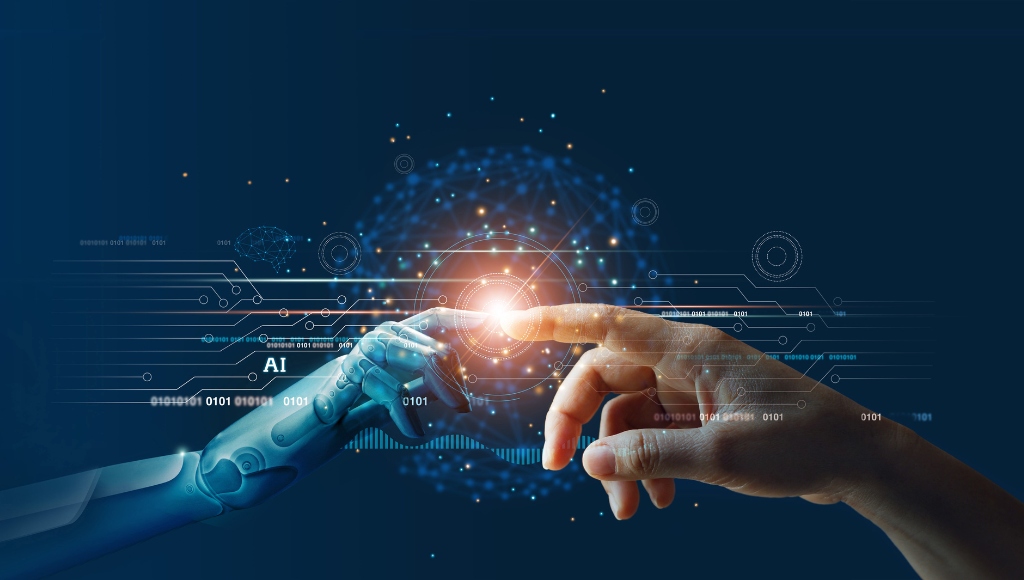Shaping The Future Of Customer Experience with Machine Teammates
-
IntouchCX Team
- April 5, 2023

To capitalize on recent advances in artificial intelligence, our framework for human-machine interaction must change from considering systems as independent task oriented machines to collaborative innovative teammates.

David Vinson PhD, Director of Research and Innovation, IntouchCX
Human-machine interactions have been around since the birth of automated systems (and likely well before). Our default thinking is that machines help to automate the more mundane aspects of work, freeing up us humans to focus on more cognitively complex tasks such as thinking. For example removing duplicates in inventory lists, sweeping the floor, etc. But if ChatGPT has exposed one thing, it is that machines have been capable of generating content for some time with the earliest examples appearing almost 70 years ago in 1966 with the simulated therapist ELIZA.
To capitalize on recent advances in artificial intelligence, our framework for human-machine interaction must change from considering systems as independent task oriented machines to collaborative innovative teammates. When we consider machines as teammates, various opportunities emerge that elevate our ability to deliver unique customer experiences.
Human-Machine Teaming (HMT) refers to the collaborative interaction between people and intelligent machines or systems. HMT is designed to augment the capabilities of both individuals and teams in order to foster improved decision making, increased efficiency, and enhanced performance outcomes. HMT requires a symbiotic relationship between humans and machines, where the strengths of each are leveraged to maximize the overall effectiveness of the team.
Human Machine Teams of the Past
Previous thinking on Human-Machine Teaming is that humans provide the context, strategy, and creativity, while the machine provides the speed, accuracy, and scalability. This matters when there are over 2.5 quintillion bytes of data published online every day and over 600 million tweets published daily. These are small fractions of a much larger puzzle of content publication, and the need to moderate content and customer experiences at high levels. In this case, Human-Machine Teaming is a bridge between humans and operating systems to be able to perform faster, and with fewer errors. Ultimately this increases our efficiency and productivity to deliver of customer experiences .
Importantly, under this paradigm effective HMT requires clear communication and – often separate – understanding of roles, goals, and expectations between the human and machine. By leveraging the independent strengths of both humans and machines, this provides faster and more accurate responses to customer inquiries, leading to improved customer satisfaction. All of these things remain the same in today’s human-machine teaming, but as machines become capable of innovation, strategy and contextual understanding, there’s much more we can do together now than ever before.
Today’s Machine Teaming is Revolutionizing Experiences
Today, HMT has the potential to change the very experiences had by consumers across all industries. Machines are becoming more and more capable of investigation, innovation and even the discovery of new physics principles. The use of generative machine algorithms and natural language understanding are proving capable of providing hyper personalized and novel experiences including generating conversational responses, visualizations and even novel ideas and concepts we would have never thought of on our own.
Humans, of course, are critical when it comes to HMT. We can learn from AI and build upon its outputs to customize and tailor experiences fit to the context of their application. Our ingenuity can then be fed back into machines using common conversational dynamics. With this, collaborative human-machine teams interactions look and feel a lot more like conversations among humans focused on the development and application of novel insights into both old and emerging problems. This is the beginning of revolutionizing the way we think about managing and creating truly excellent customer experiences.
How HMT Can Help Improve CX
There are a few major areas we see human machine teaming contributing to our partners and customer experience.
- Innovating together: Generative AI outputs provide a window into how differently machines process information compared to humans. This creates new opportunities for collaboration with new ways of thinking about the same information humans have been processing for centuries.
- Hyper-Personalization: AI systems can compute massive amounts of data and output hundreds of possible solutions. Working together, we can provide hyper-personalized recommendations and offers fit to almost any context, creating customized customer experiences.
- Sustained Expertise: AI robotic systems can keep a surgeon’s hand steady, assisting and sustaining their expert ability well after the body begins to fail them. This type of teaming extends the life cycle of specialized skills and knowledge sustaining the integrity of their application.
Applying the power of human machine teams requires thoughtful application and interdisciplinary collaborations with our partners. By leveraging the strengths of both humans and machines, we can provide a more efficient, personalized, and effective customer experience.
The Heart of the Matter
HMT has the potential to revolutionize customer experience (CX). By reframing how we think about human and machine interactions we open the door to the possibility of collaboration with our artificially intelligent counterparts. Combining the best of both human and AI skill sets and our differences, HMT enables innovative, novel, and personalized customer experiences at the speed of machine automation. Those that adopt this new framework of thinking about human machine teaming will be better equipped to handle growing customer demands, provide more effective customer interactions, and gain valuable insights into behaviors and preferences. As technology systems continue to evolve, we can expect to see even more advanced applications of human machine teaming redefining the possibilities of customer experiences.
Click here to learn more about IntouchNXT
Learn more about human-machine teaming at IntouchCX















